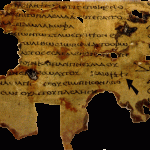When I was in Durham, it was a privilege and a delight to have gotten to know James D.G. Dunn — or “Jimmy” as he is known by many. Eerdmans recently released a collection of lectures he has given in recent years on a wide range of topics: Jesus, Paul, and the Gospels. The book is divided into three parts: What are the Gospels? From Jesus to Paul; and The Bimillennial Paul.

It is a rather short book (on the normal standard we expect from Jimmy!) – just under 200 pages. The endorsers referred to this book as a nice little “introduction” to Dunn’s life’s work on some key subjects on Jesus and Paul. I have long been familiar more with Dunn’s Paul “stuff” than his Jesus and Gospels “stuff,” so I found this little volume very handy.
In this first post, I will treat the first and second parts on Jesus and the bridge to Paul.
Chapter 1: “Fact or Fiction? How Reliable are the Gospels”
In this chapter, Dunn tries to bring some common sense to discussions about the Gospels that usually work with two poles – fact/truth or fiction/myth. Dunn seeks a middling method that takes seriously that the Gospels can be useful as “historical” sources because “The impact which Jesus had on his first disciples must be in some degree of continuity with the faith which they expressed in Jesus as risen from the dead and exalted” (p. 8). He shows frustration with the critical scholars criterion of dissimilarity – “Instead, I look for the characteristic Jesus” –
If a feature within the Jesus tradition is characteristic within the Jesus tradition, then the most obvious explanation of its presence in the Jesus tradition is that it reflects the abiding impression which Jesus made on many of his first followers (11)
Dunn moves into a number of features of the Gospels that are almost certainly “historical” – Jesus’ baptism, the crucifixion, opposition with Pharisees, proclamation of the Kingdom of God, followers, exorcisms (see pg. 20). Dunn works from a big picture of what we learn about Jesus. The details can get muddled or minor things shifted, but the substance is clear and clearly goes back to Jesus.
such a reconstruction does not guarantee the historical accuracy of recall of any particular saying or episode. But the method must certainly provide a much sounder basis for a historical reconstruction than one which depends on the evaluation of particular sayings and episodes (21)
I like the illustration he gives: “from the stamp on the paper we can discern the stamp which made it” (p. 21).
Chapter 2: “Between Jesus and the G0spels”
This chapter is, essentially, a condensed defense of his view that oral tradition and diversification is behind the Synoptic Gospels rather than a more fixed, literary-driven “redaction” view that most scholars hold. One of the features of the interrelationship between the Synoptics is those cases when there are divergences that are “inconsequential” (and thus not clearly a result of redaction): “If redaction is the only plausible or recognisable explanation, then we have to infer a casualness and arbitrariness in the redaction which can only imply a lack of respect for the authoritative original” (p. 35).
Dunn argues that when stories and teaching spread orally, there is more space for flexibility. The substance is essential and preserved, but different words could be used to get it across. Taking the differences in the Gospels from this perspective, for Dunn, helped to explain the ‘same yet different’ (38) character of the Synoptics.
Dunn, as an implication, fights the idea of an “original” version, as each “telling” is one witness, and there were many witnesses, so many “reliable” versions. While I follow what he is saying, it seems to devalue the idea that we are really working from history and the “real Jesus.”
Chapter 3: “The Birth of a New Genre: Mark and the Synoptic Gospels”
First, Dunn hypothesizes that the apostle Paul brought the term ‘gospel’ into usage by Christians, drawing especially from Isaiah and the fulfillment of covenantal hopes. When we look at Paul’s letters, there is evidence that “Paul…conveyed a good deal of Jesus tradition to the churches he founded” (p. 48). Not only that, but Dunn proposes that, even from the beginning, the earliest preaches had a “narrative structure” in mind when recalling memories of Jesus.
From there, “It was Mark’s Gospel which took the next logical step of giving the title ‘Gospel’ to his account of Jesus’ mission — ‘Gospel’ as an account which climaxed in Jesus’ death and resurrection.” (p 50). Many scholars have criticized Paul for leaving aside Jesus’ life and teaching, and focusing more on his death. However, Dunn sees this the other way around. Because Mark focuses so much on Jesus’ death and resurrection, he is reinforcing Paul’s own emphasis: “The good news of Jesus was primarily the good news of his death and resurrection” (p. 55).
Two more implications are drawn from this view of Mark. Firstly, Matthew and Luke chose to adopt Mark’s new genre, while some small divergences in form and style appear. Also, texts like “Q” “have too casually been entitled ‘Gospel'” as they do not have a good narrative structure.
Chapter 4: “A Very Different Version! John as a Source for the Historical Jesus”
He makes some key points in this chapter
1. John follows Matthew and Luke by adopting Mark’s new genre
2. The discourses of Jesus, while different in detail, are still “rooted in Synoptic-like tradition”
3. John fills in gaps left by other Gospels (p. 73)
4. John is much closer in message, stories, and form than the apocryphal Gospels (p. 74)
Chapter 5: “From Jesus’ Proclamation to Paul’s Gospel”
In this chapter, Dunn engages in that perennially perplexing issue of going from Jesus’ proclamation of the Kingdom to Paul’s focus on “justification” and the church. Dunn does a marvelous job shows strong lines of continuity, outlining a number of shared messages and themes:
– the opennness of God’s grace
-eschatological tension
-the presence and power of the Spirit
-the love command
In that sense, Dunn characterizes Paul as “one of the truest disciples of Jesus” (p. 115).
REFLECTIONS
Again, this is a fine introduction to Dunn’s highly competent treatment of major issues related to Jesus and Paul. I will offer some brief thoughts on the “Paul” chapters in another post.











